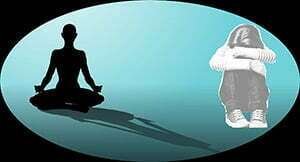The Upside of Hopeless Hopelessness
“Hope is for people who can’t see the Truth.” ? Jeff Lindsay, Dexter Is Dead
 Hopeless hopelessness is one of the great challenges we face. When we come face to face with the realization that the ego-self is powerless and helpless to resolve our suffering or to “get” us wholeness, completeness or peace.
Hopeless hopelessness is one of the great challenges we face. When we come face to face with the realization that the ego-self is powerless and helpless to resolve our suffering or to “get” us wholeness, completeness or peace.
Hope keeps ego-activity spinning – always seeking that which eludes us. A taster here, a moment there – fuel for more seeking.
“The truth is that you already are what you are seeking.” ? Adyashanti
We hear, we think we get it – and yet, the seeking continues. It really is hopeless – we can’t stop the mind from doing what it does. It’s like a lawnmower – that engine is going to keep on running until it runs out of gas. It can’t turn itself off.
“Truth is more in the process than in the result.” – Jiddu Krishnamurit
Interesting how these three quotes revolve around truth. I didn’t consciously select them with truth in mind, but they do point to something fundamental, but back to the hopelessness blues.
Feeling hopeless can give rise to the ‘blues’ – depression, sadness, unhappiness, melancholy, misery, sorrow, gloom, dejection, despondency, despair; the doldrums, the dumps, a blue funk. Hopelessness is a state without hope. Hopeless is an affect. Hopeless hopelessness is more like an active noun, but the energy is more a sense of collapse, a vacuum of energy, a of loss of aliveness and vitality.
In hopeless hopelessness lies an opportunity for clarity, for seeing the truth of the fulcrum of suffering and peace.
If you look at it closely, you’ll see that the fact is that nothing can be done. The situation is completely and totally hopeless, and the sooner you realize that hopelessness, the better for you. When you see it is 100% hopeless, only then will you stop. Now you have some hope: “If I work harder and understand all this stuff about hopelessness, then things will change.” But what are you saying? It’s the same attitude. So nothing can be done about it. You can’t get rid of it because the movement of wanting to get rid of it is, itself, the problem. You can’t try to get something else because that is the same thing as rejecting what is there.
What we are talking about is not an academic issue. It is an issue at the very heart of each one of us all the time. It is always operating. Your mind is always engaged in it. If you look at your feelings, at your thoughts, your ideas, there is always this division. There is always a part that negates another part. There is always a movement of rejecting something and hoping for something new. Every thought you have, every feeling you have, every action you take is directed toward rejection or motivated by hope. – A. H. Almaas, Diamond Heart Book II: The Freedom to Be
 The normal view of hopelessness is pretty much summed up by this quote:
The normal view of hopelessness is pretty much summed up by this quote:
Hopelessness is a really toxic and dangerous state. – Cory Booker
It is so true, from the perspective of ego-identity and ego-activity – it is totally toxic and dangerous to ego. It is not something to be taken lightly. Without support, guidance and understanding we may not be able to allow transformation. Which brings to mind one of my favorite insights – we cannot change, but we can be changed.
The transformative power of hardship, therefore, lies in your ability to understand your role and see beyond the hopelessness. “It’s very liberating,” Adyashanti says. “The keys to your happiness are no longer in somebody else’s pocket from the past. They’re in yours. And that’s empowering.” Full article and video»
St. John of the Cross’ Dark Night of the Soul – “Now that I no longer desire all, I have it all without desire.”
[wpdevart_youtube]ZF9CFBf3DHs[/wpdevart_youtube]